状语从句
- 格式:ppt
- 大小:269.50 KB
- 文档页数:48

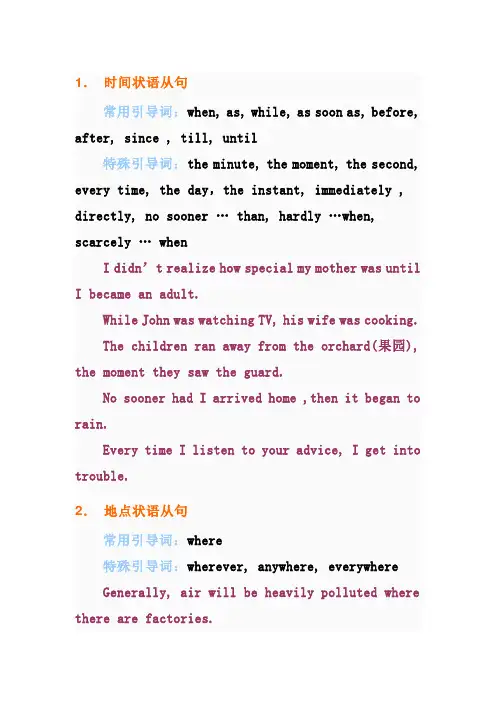
1.时间状语从句常用引导词:when, as, while, as soon as, before, after, since , till, until特殊引导词:the minute, the moment, the second, every time, the day,the instant, immediately , directly, no sooner … than, hardly …when, scarcely … whenI didn’t realize how special my mother was until I became an adult.While John was watching TV, his wife was cooking.The children ran away from the orchard(果园), the moment they saw the guard.No sooner had I arrived home ,then it began to rain.Every time I listen to your advice, I get into trouble.2.地点状语从句常用引导词:where特殊引导词:wherever, anywhere, everywhereGenerally, air will be heavily polluted where there are factories.Wherever you go, you should work hard.地点状语从句§4地点状语从句 (adverbial clause of place) 地点状语从句一般由连接副词where, wherever等引导,已经形成了固定的句型,例如:句型1:Where+地点从句,(there)+主句。
【注意】此句型通常译成“哪里……哪里就……”;主句在从句后面时,there可用可不用;如果主句在从句的前面时,一般都不用there。
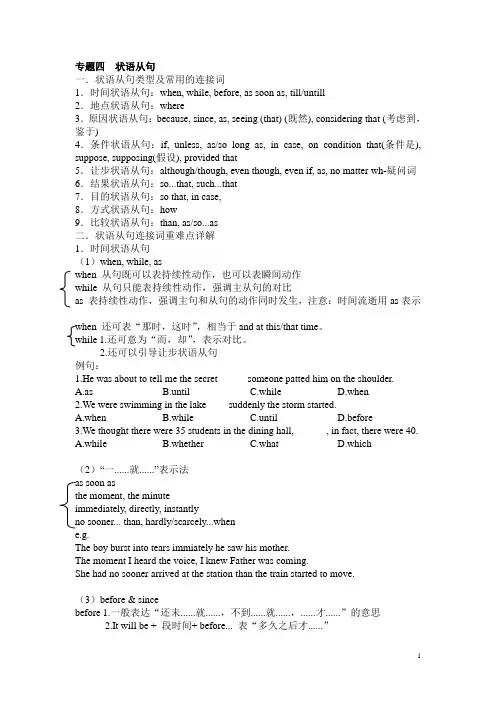
专题四状语从句一.状语从句类型及常用的连接词1.时间状语从句:when, while, before, as soon as, till/untill2.地点状语从句:where3.原因状语从句:because, since, as, seeing (that) (既然), considering that (考虑到,鉴于)4.条件状语从句:if, unless, as/so long as, in case, on condition that(条件是), suppose, supposing(假设), provided that5.让步状语从句:although/though, even though, even if, as, no matter wh-疑问词6.结果状语从句:so...that, such...that7.目的状语从句:so that, in case,8.方式状语从句:how9.比较状语从句:than, as/so...as二.状语从句连接词重难点详解1.时间状语从句(1)when, while, aswhen 从句既可以表持续性动作,也可以表瞬间动作while 从句只能表持续性动作,强调主从句的对比as 表持续性动作,强调主句和从句的动作同时发生,注意:时间流逝用as表示还可表“那时,这时”,相当于and at this/that time。
while 1.还可意为“而,却”,表示对比。
2.还可以引导让步状语从句例句:1.He was about to tell me the secret _____ someone patted him on the shoulder.A.asB.untilC.whileD.when2.We were swimming in the lake____ suddenly the storm started.A.whenB.whileC.untilD.before3.We thought there were 35 students in the dining hall, ______, in fact, there were 40.A.whileB.whetherC.whatD.which(2)“一......就......”表示法the moment, the minuteimmediately, directly, instantlyno sooner... than, hardly/scarcely...whene.g.The boy burst into tears immiately he saw his mother.The moment I heard the voice, I knew Father was coming.She had no sooner arrived at the station than the train started to move.(3)before & sincebefore 1.一般表达“还未......就......,不到......就......,......才......”的意思2.It will be + 段时间+ before... 表“多久之后才......”since 1.表“自从.......”从句一般用一般过去时,主句的时态一般为现在完成时或者现在完成进行时。
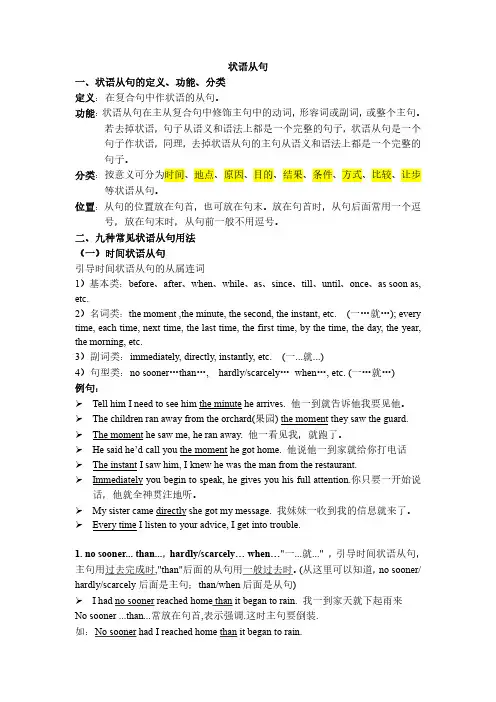
状语从句一、状语从句的定义、功能、分类定义:在复合句中作状语的从句。
功能:状语从句在主从复合句中修饰主句中的动词,形容词或副词,或整个主句。
若去掉状语,句子从语义和语法上都是一个完整的句子,状语从句是一个句子作状语,同理,去掉状语从句的主句从语义和语法上都是一个完整的句子。
分类:按意义可分为时间、地点、原因、目的、结果、条件、方式、比较、让步等状语从句。
位置:从句的位置放在句首,也可放在句末。
放在句首时,从句后面常用一个逗号,放在句末时,从句前一般不用逗号。
二、九种常见状语从句用法(一)时间状语从句引导时间状语从句的从属连词1)基本类:before、after、when、while、as、since、till、until、once、as soon as, etc.2)名词类:the moment ,the minute, the second, the instant, etc. (一…就…); every time, each time, next time, the last time, the first time, by the time, the day, the year, the morning, etc.3)副词类:immediately, directly, instantly, etc. (一...就...)4)句型类:no sooner…than…, hardly/scarcely…when…, etc. (一…就…)例句:Tell him I need to see him the minute he arrives. 他一到就告诉他我要见他。
The children ran away from the orchard(果园) the moment they saw the guard.The moment he saw me, he ran away. 他一看见我,就跑了。

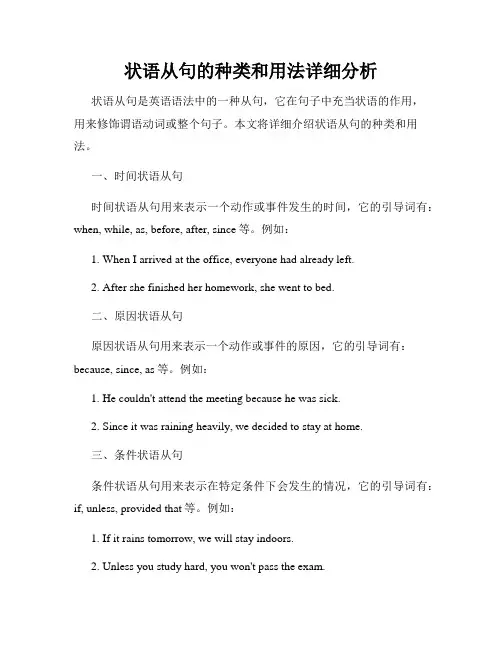
状语从句的种类和用法详细分析状语从句是英语语法中的一种从句,它在句子中充当状语的作用,用来修饰谓语动词或整个句子。
本文将详细介绍状语从句的种类和用法。
一、时间状语从句时间状语从句用来表示一个动作或事件发生的时间,它的引导词有:when, while, as, before, after, since等。
例如:1. When I arrived at the office, everyone had already left.2. After she finished her homework, she went to bed.二、原因状语从句原因状语从句用来表示一个动作或事件的原因,它的引导词有:because, since, as等。
例如:1. He couldn't attend the meeting because he was sick.2. Since it was raining heavily, we decided to stay at home.三、条件状语从句条件状语从句用来表示在特定条件下会发生的情况,它的引导词有:if, unless, provided that等。
例如:1. If it rains tomorrow, we will stay indoors.2. Unless you study hard, you won't pass the exam.四、方式状语从句方式状语从句用来表示一个动作或事件的方式,它的引导词有:as, like等。
例如:1. You should do it as I told you.2. He acted like he didn't care about anything.五、地点状语从句地点状语从句用来表示一个动作或事件的地点,它的引导词有:where, wherever等。
例如:1. I will go wherever you go.2. The children played in the park where their parents could watch them.六、目的状语从句目的状语从句用来表示一个动作或事件的目的,它的引导词有:so that, in order that等。
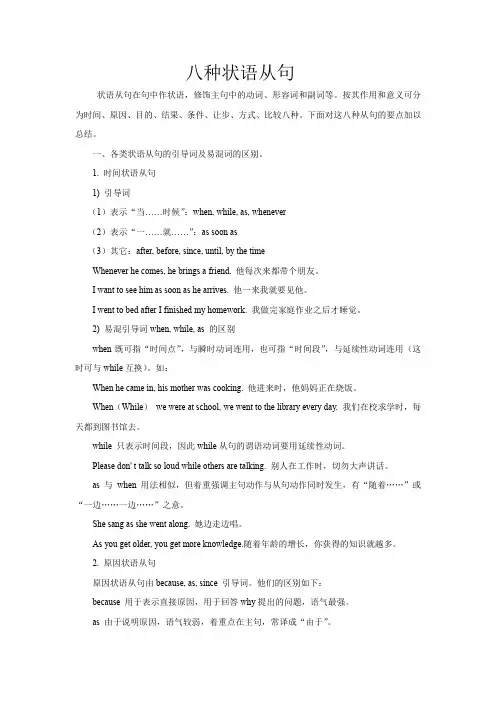
八种状语从句状语从句在句中作状语,修饰主句中的动词、形容词和副词等。
按其作用和意义可分为时间、原因、目的、结果、条件、让步、方式、比较八种。
下面对这八种从句的要点加以总结。
一、各类状语从句的引导词及易混词的区别。
1. 时间状语从句1) 引导词(1)表示“当……时候”:when, while, as, whenever(2)表示“一……就……”:as soon as(3)其它:after, before, since, until, by the timeWhenever he comes, he brings a friend. 他每次来都带个朋友。
I want to see him as soon as he arrives. 他一来我就要见他。
I went to bed after I finished my homework. 我做完家庭作业之后才睡觉。
2) 易混引导词when, while, as 的区别when既可指“时间点”,与瞬时动词连用,也可指“时间段”,与延续性动词连用(这时可与while互换)。
如:When he came in, his mother was cooking. 他进来时,他妈妈正在烧饭。
When(While)we were at school, we went to the library every day. 我们在校求学时,每天都到图书馆去。
while 只表示时间段,因此while从句的谓语动词要用延续性动词。
Please don' t talk so loud while others are talking. 别人在工作时,切勿大声讲话。
as 与when 用法相似,但着重强调主句动作与从句动作同时发生,有“随着……”或“一边……一边……”之意。
She sang as she went along. 她边走边唱。
As you get older, you get more knowledge.随着年龄的增长,你获得的知识就越多。
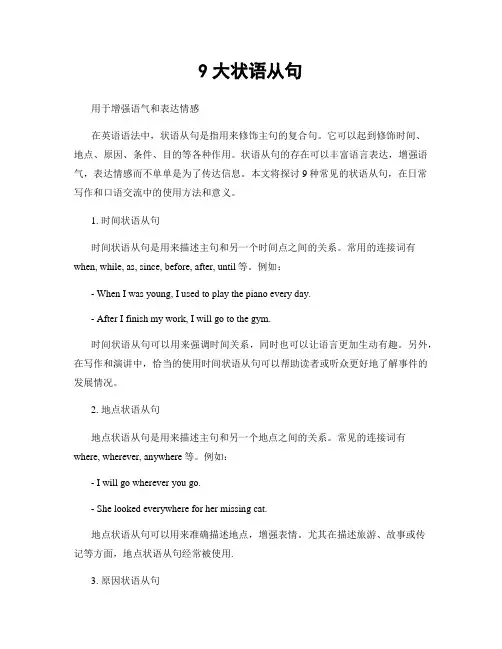
9大状语从句用于增强语气和表达情感在英语语法中,状语从句是指用来修饰主句的复合句。
它可以起到修饰时间、地点、原因、条件、目的等各种作用。
状语从句的存在可以丰富语言表达,增强语气,表达情感而不单单是为了传达信息。
本文将探讨9种常见的状语从句,在日常写作和口语交流中的使用方法和意义。
1. 时间状语从句时间状语从句是用来描述主句和另一个时间点之间的关系。
常用的连接词有when, while, as, since, before, after, until等。
例如:- When I was young, I used to play the piano every day.- After I finish my work, I will go to the gym.时间状语从句可以用来强调时间关系,同时也可以让语言更加生动有趣。
另外,在写作和演讲中,恰当的使用时间状语从句可以帮助读者或听众更好地了解事件的发展情况。
2. 地点状语从句地点状语从句是用来描述主句和另一个地点之间的关系。
常见的连接词有where, wherever, anywhere等。
例如:- I will go wherever you go.- She looked everywhere for her missing cat.地点状语从句可以用来准确描述地点,增强表情。
尤其在描述旅游、故事或传记等方面,地点状语从句经常被使用.3. 原因状语从句原因状语从句是用来描述主句和某个原因之间的关系。
常见的连接词有because, since, as, for等。
例如:- Because it was raining, I stayed at home last night.- I don't like to eat fish, for I am allergic to it.原因状语从句可以强调某个事件的原因,增强语气。
通过使用原因状语从句,写作者或者说话人可以清晰地表达某个事情的原因,使文章更加步入事实,增强可信程度。
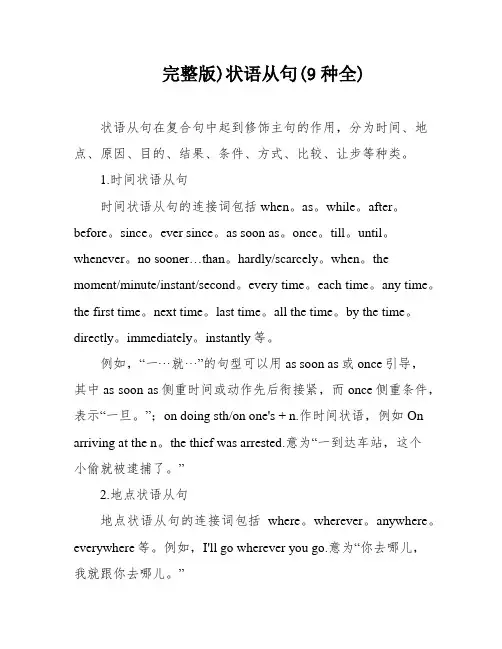
完整版)状语从句(9种全)状语从句在复合句中起到修饰主句的作用,分为时间、地点、原因、目的、结果、条件、方式、比较、让步等种类。
1.时间状语从句时间状语从句的连接词包括when。
as。
while。
after。
before。
since。
ever since。
as soon as。
once。
till。
until。
whenever。
no sooner…than。
hardly/scarcely。
when。
the moment/minute/instant/second。
every time。
each time。
any time。
the first time。
next time。
last time。
all the time。
by the time。
directly。
immediately。
instantly等。
例如,“一···就···”的句型可以用as soon as或once引导,其中as soon as侧重时间或动作先后衔接紧,而once侧重条件,表示“一旦。
”;on doing sth/on one's + n.作时间状语,例如On arriving at the n。
the thief was arrested.意为“一到达车站,这个小偷就被逮捕了。
”2.地点状语从句地点状语从句的连接词包括where。
wherever。
anywhere。
everywhere等。
例如,I'll go wherever you go.意为“你去哪儿,我就跟你去哪儿。
”3.原因状语从句原因状语从句的连接词包括because。
since。
as。
now that。
seeing that。
considering that等。
例如,Since it's raining。
we'll stay indoors.意为“因为下雨,我们将待在室内。
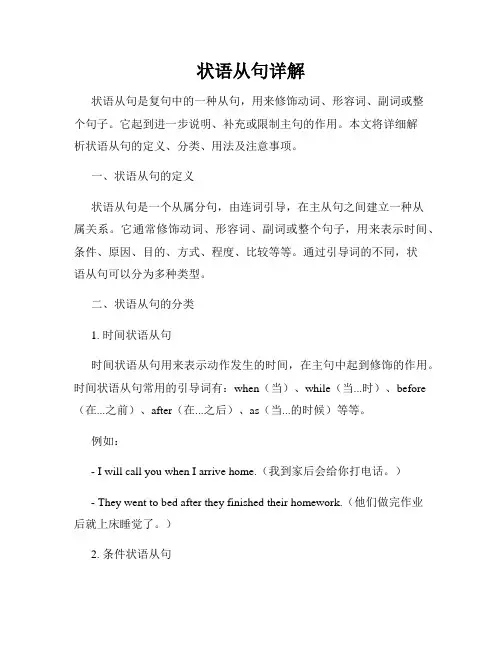
状语从句详解状语从句是复句中的一种从句,用来修饰动词、形容词、副词或整个句子。
它起到进一步说明、补充或限制主句的作用。
本文将详细解析状语从句的定义、分类、用法及注意事项。
一、状语从句的定义状语从句是一个从属分句,由连词引导,在主从句之间建立一种从属关系。
它通常修饰动词、形容词、副词或整个句子,用来表示时间、条件、原因、目的、方式、程度、比较等等。
通过引导词的不同,状语从句可以分为多种类型。
二、状语从句的分类1. 时间状语从句时间状语从句用来表示动作发生的时间,在主句中起到修饰的作用。
时间状语从句常用的引导词有:when(当)、while(当...时)、before (在...之前)、after(在...之后)、as(当...的时候)等等。
例如:- I will call you when I arrive home.(我到家后会给你打电话。
)- They went to bed after they finished their homework.(他们做完作业后就上床睡觉了。
)2. 条件状语从句条件状语从句用来表示主句发生的条件,在主句中起到修饰的作用。
条件状语从句常用的引导词有:if(如果)、unless(除非)、provided that(只要)、as long as(只要)等等。
例如:- If it rains, we will stay at home.(如果下雨,我们将待在家里。
)- You can go out unless it is too cold.(除非天气太冷,你可以出去。
)3. 原因状语从句原因状语从句用来表示主句发生的原因,在主句中起到修饰的作用。
原因状语从句常用的引导词有:because(因为)、since(因为)、as (因为)、for(因为)等等。
例如:- She didn't come to the party because she was sick.(她没有来参加聚会,因为她生病了。
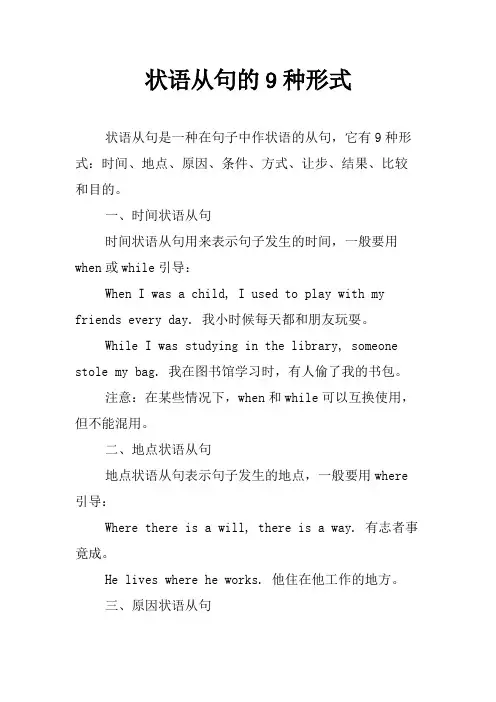
状语从句的9种形式状语从句是一种在句子中作状语的从句,它有9种形式:时间、地点、原因、条件、方式、让步、结果、比较和目的。
一、时间状语从句时间状语从句用来表示句子发生的时间,一般要用when或while引导:When I was a child, I used to play with my friends every day. 我小时候每天都和朋友玩耍。
While I was studying in the library, someone stole my bag. 我在图书馆学习时,有人偷了我的书包。
注意:在某些情况下,when和while可以互换使用,但不能混用。
二、地点状语从句地点状语从句表示句子发生的地点,一般要用where 引导:Where there is a will, there is a way. 有志者事竟成。
He lives where he works. 他住在他工作的地方。
三、原因状语从句原因状语从句表示句子发生的原因,一般要用why或because引导:Why she is late? 她为什么迟到?Because it was raining heavily, I couldn't get to school on time. 因为下着大雨,我上不了学。
四、条件状语从句条件状语从句表示句子发生的条件,一般要用if或unless引导:If you study hard, you'll pass the exam. 如果你努力学习,你就能通过考试。
Unless you work harder, you won't get better grades. 除非你更努力工作,否则你的分数不会提高。
五、方式状语从句方式状语从句表示句子的发生方式,一般要用as或how引导:As I said before, I'll help you with your project. 就像我之前说的,我会帮助你完成这个项目。
定义:在复合句中,用来充当状语的句子称为状语从句。
功能:它主要用于修饰句子中的谓语动词、形容词或副词等,有时修饰整个句子。
位置:状语从句的位置较活:可以放在主句之前,用逗号与主句隔开;也可以放在主句之后,一般不用逗号。
由于它是从各个方面来修饰、说明谓语动词发生时的各种情况,所以常见的状语从句有九种之多。
各种不同的状语从句所使用的关系词也各不相同。
一、时间状语从句:1、引导词:A: 常用连词有:when, while, as, before, after, since, once, till, untilB: 特殊引导词:as soon as, the moment ,hardly…when…, scarcely…when…, no sooner…than…,by the time, the minute, the instant, immediately, directly, every time等。
When they heard the news,they all jumped with joy.While I was reading,he came in.Once you remember it,you’ll never forget it.The moment I heard the voice,We had no sooner arrivedI had hardly got home when it began to rain.I hadn’t understood the problem until he explained it.Every/Each time I was in trouble,Next time you come,do remember to bring your son here.Please remember to turn off all the lights before you leave the classroom.I have worked here since I graduated from the university.After he had left school, he joined the army.They always sing as we walk.By the time he gets there, his father has already gone.2、在时间状语从句中,主句是一般将来时,从句通常用一般现在时表示将来。
九种状语从句状语从句是语法中的重要部分,它可以用来修饰、限定或描述主句中的动词、形容词、副词等成分。
一篇内容生动、全面、有指导意义的文章需要运用九种常见的状语从句,让文章更加丰富有趣。
下面就让我们一起来探讨这九种状语从句吧!1. 时间状语从句当我们谈论过去、现在或未来的事件时,时间状语从句可以帮助我们明确时间的关系。
比如:“当我正在赶路时,突然下起了雨。
”、“如果明天你有时间,我们可以一起去看电影。
”2. 原因状语从句原因状语从句可以解释为什么某个事件发生或造成某种结果。
比如:“因为他疲惫不堪,所以他决定休息一天。
”、“由于下雪,他无法开车去上班。
”3. 条件状语从句条件状语从句用来表达某种条件下,某个动作或事件将会发生或不会发生。
比如:“如果你努力学习,你一定会成功。
”、“除非天气恶劣,否则比赛将如期举行。
”4. 比较状语从句比较状语从句用来比较两个或多个事物之间的差异或相似之处。
比如:“他弟弟比他更高。
”、“这个城市比我之前去过的任何一个城市都要美丽。
”5. 目的状语从句目的状语从句用来说明一个动作的目的或意图。
比如:“我带着伞出门,以便在下雨时不被淋湿。
”、“我希望今天能早点完成工作,以便有时间陪家人。
”6. 结果状语从句结果状语从句用来描述某个动作或事件的结果。
比如:“他在考试中取得了好成绩,因此他非常开心。
”、“他没来参加会议,结果被罚款了。
”7. 让步状语从句让步状语从句用来表示与主句相反或相对独立的情况。
比如:“尽管她很累,但她还是坚持完成了任务。
”、“虽然下雨了,但我们还是坚持去爬山。
”8. 方式状语从句方式状语从句用来描述某个动作或事件的方式或方法。
比如:“他走路时像风一样迅速。
”、“我用力地挥舞着手臂,好让朋友看到我。
”9. 地点状语从句地点状语从句用来说明一个动作或事件发生的地点。
比如:“我们约定在公园里见面。
”、“我在你旁边坐着等你。
”通过运用这九种状语从句,我们可以大大丰富文章的表达,使文章更加生动、有趣。
状语从句在复合句中作状语的从句叫状语从句。
状语从句有时间、地点、原因、目的、结果、条件、方式、比较、让步等种类。
一、时间状语从句引导时间状语从句的连接词有: when, as, while, after, before, since, ever since, as soon as, once, till, until, whenever, no sooner…than, hardly/scarcely...when, themoment/minute/instant/second, every time, each time, any time, the first time, next time, last time, all the time, by the time, directly, immediately, instantly等。
1.表示“一···就···”的句型1) as soon as/onceAs soon as he arrives, I'll call you.他一到,我就给你打电话。
(as soon as 侧重时间或动作先后衔接紧,而once侧重条件,表示“一旦...”)2) on doing sth/on one's + n.作时间状语On arriving at the station, the thief was arrested.一到达车站,这个小偷就被逮捕了。
On his arrival in Paris, he was recognized as a noble and thrown into prison. 他一到达巴黎,就被认出是一个贵族,并被投入监狱。
3) no sooner ...than , hardly/scarcely...when它们表“一…就”。
结构中的否定词放在句首时,主句要倒装。
状语从句例子状语从句是指一句话中,修饰主句的从句。
它可以在句子中充当状语,表示时间、地点、原因、条件等。
翻译成中文后,常常放在主句前面。
一、时间状语从句时间状语从句用来表示一个动作或事情发生的时间。
例如:When I left home this morning, it was raining.(当我今天早上离开家的时候下雨了。
)在这个句子中,“when”是时间状语从句的引导词,修饰主句中的“it was raining”。
二、地点状语从句地点状语从句用来表示一个动作或事情发生的地点。
例如:Wherever you go, there you are.(你走到哪里,你就在哪里。
)在这个句子中,“wherever”是地点状语从句的引导词,修饰主句中的“there”。
三、原因状语从句原因状语从句用来表示一个动作或事情发生的原因。
例如:Since I'm feeling better, I think I'll go for a walk.(因为我感觉好多了,所以我想去散步。
)在这个句子中,“since”是原因状语从句的引导词,修饰主句中的“I think I'll go for a walk”。
四、条件状语从句条件状语从句用来表示一个动作或事情发生的条件。
例如:If I had more money, I would travel more.(如果我有更多的钱,我会旅行得更多。
)在这个句子中,“if”是条件状语从句的引导词,修饰主句中的“I would travel more”。
总之,状语从句是英语中非常重要的语法结构之一,掌握好它的用法对于提高英语水平有着非常大的帮助。
在学习的过程中,可以通过大量阅读和练习来掌握状语从句的用法,并在写作时适当运用。